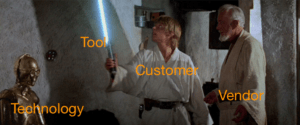Congratulations! In addition to your regular job, you also run a media company because every company is a media company.
“That’s ridiculous!” We’re a consulting company, or a software company, or a law firm. Or we manufacture widgets. “We’re the opposite of a media company,” you protest. At least I did, when the idea occurred to me.
But here’s the thing– the most precious commodity is not money or even time, although both of those things are valuable– it’s attention. Without attention, your market doesn’t know you exist. They can’t buy from you. Without enough attention, you may not be able to effectively serve your actual customers.
Attention means different things in different contexts. Consider:
- A surgeon discussing an upcoming heart surgery.
- A one-on-one meeting with a prospect to discuss a new strategic initiative and how you can help.
- Presenting to a local business group over lunch.
- An ephemeral tweet in your prospect’s Twitter stream. (Do they follow you? Are they on Twitter at exactly the right moment?)
- A Google or Facebook ad.
- A Super Bowl ad.
All of these situations involve attention at different levels and with different results.
What kind of attention do you need?
This depends on how your customers buy. A fancy chocolate bar near the registers in a supermarket only needs to grab your attention for a split second to convince you to grab it as you unload your cart. More complex buying decisions require more attention over a longer period of time.
Think about the last major purchase you made, whether business or personal. How much attention did the decision require? And what kind of attention?
In most cases, you go from awareness of a problem, to searching for a solution, to qualifying one or more options, to moving forward (or not).
You can’t skip a step.
For example, suppose your car gets totaled and you need a new car ASAP. You have awareness of the problem and you can start searching for a solution.
But the day before, when your car was fine, if someone started presenting you with detailed technical specs of cars, you would have tuned them out.
The key is to align the message with the relevant stage for the buyer. If I’m really hungry, offering me food is great. But if I just ate, offering me more food isn’t going to lead me eating more (well, at least in theory). However, you could offer some information on “Food for Nerds” or whatever, to help me think about food, so that next time I go to eat, I’m primed to want what you offer.
Too much of attention-seeking behavior is just “here, eat another one. Here’s why it’s awesome.”
As we see with proposals, which are a way to get attention later in the sales cycle, attention-seeking earlier in the funnel should respect the rules of the proposal:
- A proposal is a story, not a brochure.
- The story stars the buyer, not the seller.
So the question becomes:
What is the buyer’s story?
By the time we reach the proposal, we should know, but what happens earlier?
What is the state of mind of the prospect when they start becoming aware of a problem? When they start searching for a solution?
And, instead of just trying to saturate media with our message (pretty much impossible for small business, anyway), how can we tailor it to not only get through, but also be helpful? There’s always a temptation to “cheat”– to use clickbait or other shady tactics to get attention, but then how do we keep it?
If you don’t know the story, the easiest thing to do is ask. Ask your current customers. Don’t try to shoe horn what they say into your product and services. Pay close attention to their words. Target as narrowly as you can. When it comes to getting attention, speaking directly to someone’s needs will give better results than speaking vaguely to lots of people’s concerns.
For example: “The food we should all be eating, according to doctors.” Versus: “We found the perfect food for people who spend too much time front of a computer.” Which one will be more interesting to me, sadly? 😉
This can also help you cut through the oversaturation of messages. There was a time when a simple text ad in a newspaper or magazine could drive a lot of sales. Now there’s so much self-promotion that most of us are turned off. We subconsciously ignore ads, spam, and general crap in our inboxes, on our web pages, in social networks, and more. Remember that if every company is a media company, this means that your competitors and everyone else vying for the attention of your prospect is a media company, too.
It’s easy to see that other people are creating crap. Sometimes it’s harder to recognize that we are creating what other people will see as crap. If we keep the buyer at the center of the story, this gets much easier. (“What would I want at this stage in my buying process?”)
Creating Content
Most of us don’t have the time to create and distribute as much content as we “should”. So we have to be careful about what we commit to do. It’s easy to fill up a marketing calendar with 10 blog posts and 50 other activities each month, but if we get to the end of the month and we’ve got 2 blog posts and we haven’t done 44 of the other activities, we may give up entirely, and we won’t be as effective as we would be if we had committed to 2 blog posts and 6 supporting activities. So keep it realistic.
Also, know your strengths. Some people are great writers but very camera shy. Blogging, white papers, and other written material is great for these folks. Some people hate to write but have no problem talking. Don’t make them write. Have them record videos or podcasts or something else where their “gift of gab” can we useful.
Whatever medium you use, ask “what do I add to the buyer’s journey?” If you just say “me, too!”, it’s going to be hard for people to hear you. What’s different about your perspective? As Matthew Pollard notes in his Sales for Nerds interview, this is often something that’s so natural to us that we take it for granted, but other people find it extra-ordinary.
Follow the Oprah Strategy
Whatever format works best for you (and your audience), you can convert the same basic content into different media, which is exactly what Oprah does. You can record a segment for your TV show (or YouTube channel), turn a transcript into a blog post, turn an except of that into a newsletter, include the bullet points in SlideShare presentation, and as individual tweets or LinkedIn updates. You can also share links to any and all of this content on social media.
This makes your time and creativity go a lot further, and makes it more likely that you can get the attention of someone in your audience.
Distributing Content
After taking lots of time to create great content, who has time for distribution? I know I used to post a couple of useless tweets to my latest blog post, and maybe a LinkedIn update. Sometimes I’d reach out via my newsletter, if I was keeping up with that. ;-P
There’s an old saying in Hollywood: “Content is king, but distribution is King Kong.”
(I’d make the case that Hollywood is much better at distribution than content, as this promo for a King Kong sequel suggests.)
If your content falls in a forest and no one hears it, do you get any attention?
Do make sure you have a good strategy to distribute your content to your audience. Here are some ideas:
- Talk about your ideas with people you meet. Sounds obvious, but so many people don’t want to talk about their key insights because they don’t want to sound self-promotional. I appreciate that, and I may not want to download your 20 page white paper, but share your point of view. (This is a pretty big failing of mine. I’ve been meaning to write this blog post for almost a year, but never felt like I had everything worked out perfectly. I finally decided not to wait for perfection.)
- Send links to your content to your mailing list. Again, it sounds obvious, but it takes time and energy.
- Share in places online where you audience spends time. This requires knowing your audience, of course, and will be different for everyone.
- What forums or discussion groups do your prospects join? (Many times on LinkedIn, people join groups of their peers, which is great, but your prospects may be somewhere else.)
- What voices in your community have the most interesting stories and the most listeners? Engage them in conversation, and they may engage you, expanding your audience. But if you just spam them and expect them to help you, it probably won’t work. 😉
- If your business is local, are there local organizations like Meetups, Vistage groups, Chamber of Commerce, colleges, or other places that may be interested in having content that will help their members? (You may also get to address some of these groups in person.)
- If your business has particular industry affinity, what industry associations or publications serve your audience? And how can you help them by providing great content?
Recap: Rules for Media Companies
- Your company is a media company. Whether you like it or not, you need attention. Media companies are about getting attention.
- Every other company is a media company, too.
- Align your attention-seeking message to the stage of buyer’s journey. Don’t just try to close if they are just learning about the problem.
- Put your buyer at the center of the story.
- Bring a different perspective that will stand out from all the noise.
- Play to your strengths in content creation– you repurpose content once you have it.
- Content may be king, but distribution is King Kong– have a way to get your message to your audience.
All of these rules deserve much more detail, which I’ll be going into throughout the year.
But do you agree? Do you work for a media company?
Stuck on content ideas? Here’s a way to start. Get 22 Consulting Lead Magnet concepts that you can use on your site today. (Not a consultant, that’s ok, most of them are pretty adaptable.)


